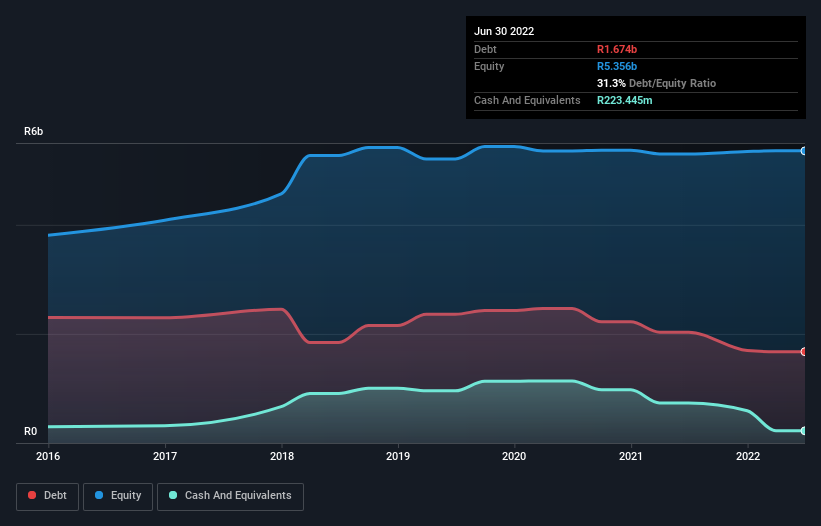- South Africa
- /
- Food
- /
- JSE:LBR
These 4 Measures Indicate That Libstar Holdings (JSE:LBR) Is Using Debt Extensively
Warren Buffett famously said, 'Volatility is far from synonymous with risk.' It's only natural to consider a company's balance sheet when you examine how risky it is, since debt is often involved when a business collapses. Importantly, Libstar Holdings Limited (JSE:LBR) does carry debt. But should shareholders be worried about its use of debt?
When Is Debt A Problem?
Debt and other liabilities become risky for a business when it cannot easily fulfill those obligations, either with free cash flow or by raising capital at an attractive price. In the worst case scenario, a company can go bankrupt if it cannot pay its creditors. However, a more usual (but still expensive) situation is where a company must dilute shareholders at a cheap share price simply to get debt under control. By replacing dilution, though, debt can be an extremely good tool for businesses that need capital to invest in growth at high rates of return. The first step when considering a company's debt levels is to consider its cash and debt together.
View our latest analysis for Libstar Holdings
What Is Libstar Holdings's Debt?
You can click the graphic below for the historical numbers, but it shows that Libstar Holdings had R1.67b of debt in June 2022, down from R2.03b, one year before. However, it does have R223.4m in cash offsetting this, leading to net debt of about R1.45b.

How Strong Is Libstar Holdings' Balance Sheet?
We can see from the most recent balance sheet that Libstar Holdings had liabilities of R2.15b falling due within a year, and liabilities of R2.35b due beyond that. Offsetting these obligations, it had cash of R223.4m as well as receivables valued at R1.73b due within 12 months. So it has liabilities totalling R2.55b more than its cash and near-term receivables, combined.
This is a mountain of leverage relative to its market capitalization of R3.72b. Should its lenders demand that it shore up the balance sheet, shareholders would likely face severe dilution.
We measure a company's debt load relative to its earnings power by looking at its net debt divided by its earnings before interest, tax, depreciation, and amortization (EBITDA) and by calculating how easily its earnings before interest and tax (EBIT) cover its interest expense (interest cover). Thus we consider debt relative to earnings both with and without depreciation and amortization expenses.
Libstar Holdings's net debt is sitting at a very reasonable 1.5 times its EBITDA, while its EBIT covered its interest expense just 4.1 times last year. While these numbers do not alarm us, it's worth noting that the cost of the company's debt is having a real impact. We saw Libstar Holdings grow its EBIT by 5.2% in the last twelve months. That's far from incredible but it is a good thing, when it comes to paying off debt. When analysing debt levels, the balance sheet is the obvious place to start. But ultimately the future profitability of the business will decide if Libstar Holdings can strengthen its balance sheet over time. So if you want to see what the professionals think, you might find this free report on analyst profit forecasts to be interesting.
Finally, a business needs free cash flow to pay off debt; accounting profits just don't cut it. So we clearly need to look at whether that EBIT is leading to corresponding free cash flow. Over the most recent three years, Libstar Holdings recorded free cash flow worth 51% of its EBIT, which is around normal, given free cash flow excludes interest and tax. This cold hard cash means it can reduce its debt when it wants to.
Our View
While Libstar Holdings's interest cover makes us cautious about it, its track record of staying on top of its total liabilities is no better. At least its net debt to EBITDA gives us reason to be optimistic. We think that Libstar Holdings's debt does make it a bit risky, after considering the aforementioned data points together. That's not necessarily a bad thing, since leverage can boost returns on equity, but it is something to be aware of. There's no doubt that we learn most about debt from the balance sheet. But ultimately, every company can contain risks that exist outside of the balance sheet. Be aware that Libstar Holdings is showing 2 warning signs in our investment analysis , you should know about...
At the end of the day, it's often better to focus on companies that are free from net debt. You can access our special list of such companies (all with a track record of profit growth). It's free.
New: AI Stock Screener & Alerts
Our new AI Stock Screener scans the market every day to uncover opportunities.
• Dividend Powerhouses (3%+ Yield)
• Undervalued Small Caps with Insider Buying
• High growth Tech and AI Companies
Or build your own from over 50 metrics.
Have feedback on this article? Concerned about the content? Get in touch with us directly. Alternatively, email editorial-team (at) simplywallst.com.
This article by Simply Wall St is general in nature. We provide commentary based on historical data and analyst forecasts only using an unbiased methodology and our articles are not intended to be financial advice. It does not constitute a recommendation to buy or sell any stock, and does not take account of your objectives, or your financial situation. We aim to bring you long-term focused analysis driven by fundamental data. Note that our analysis may not factor in the latest price-sensitive company announcements or qualitative material. Simply Wall St has no position in any stocks mentioned.
About JSE:LBR
Libstar Holdings
Manufactures, distributes, and markets branded and private label consumer packaged goods in South Africa and internationally.
Undervalued with excellent balance sheet.
Similar Companies
Market Insights
Community Narratives



